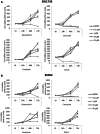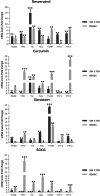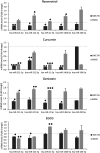Effects of nutraceuticals on anaplastic thyroid cancer cells
- PMID: 29197967
- PMCID: PMC11813496
- DOI: 10.1007/s00432-017-2555-7
Effects of nutraceuticals on anaplastic thyroid cancer cells
Abstract
Purpose: The anaplastic thyroid carcinoma (ATC) is the most aggressive thyroid cancer with a high mortality rate. Since nutraceuticals may exert beneficial effects on tumor biology, here, effects of four of these compounds [resveratrol, genistein, curcumin and epigallocatechin-3-gallate (EGCG)] on ATC cell lines were investigated.
Methods: Two ATC-derived cell lines were used: SW1736 and 8505C. Cell viability and in vitro aggressiveness was tested by MTT and soft agar assays. Apoptosis was investigated by Western Blot, using an anti-cleaved-PARP antibody. mRNA and miRNA levels were quantified by real-time PCR.
Results: All tested nutraceuticals caused in both cell lines decrease of cell viability and increase of apoptosis. In contrast, only curcumin reduced in vitro aggressiveness in both SW1736 and 8505C cell lines, while genistein and EGCG determined a reduction of colony formation only in 8505C cells. Effects on genes related to the thyroid-differentiated phenotype were also tested: resveratrol and genistein administration determined the increment of almost all tested mRNAs in both cell lines. Instead curcumin and EGCG treatments had opposite effects in the two cell lines, causing the increment of almost all the mRNAs in 8505C cells and their reduction in SW1736. Finally, effects of nutraceuticals on levels of several miRNAs, known as important in thyroid cancer progression (hsa-miR-221, hsa-miR-222, hsa-miR-21, hsa-miR-146b, hsa-miR-204), were tested. Curcumin induced a strong and significant reduction of all miR analyzed, except for has-miR-204, in both cell lines.
Conclusions: Altogether, our results clearly indicate the anti-cancer proprieties of curcumin, suggesting the promising use of this nutraceutical in ATC treatment. Resveratrol, genistein and EGCG have heterogeneous effects on molecular features of ATC cells.
Keywords: Curcumin; EGCG, ATC; Genistein; Nutraceuticals; Resveratrol.
Conflict of interest statement
The authors declare that they have no conflict of interest.
Figures





References
-
- Aggarwal BB, Shishodia S (2006) Molecular targets of dietary agents for prevention and therapy of cancer. Biochem Pharmacol 71:1397–1421. 10.1016/j.bcp.2006.02.009 - PubMed
-
- Allegri L, Baldan F, Mio C, Puppin C, Russo D, Kryštof V, Damante G (2016) Effects of BP-14, a novel cyclin-dependent kinase inhibitor, on anaplastic thyroid cancer cells. Oncol Rep 35:2413–2418. 10.3892/or.2016.4614 - PubMed
-
- Asou H, Koshizuka K, Kyo T, Takata N, Kamada N, Koeffier HP (2002) Resveratrol, a natural product derived from grapes, is a new inducer of differentiation in human myeloid leukemias. Int J Hematol 75:528–533 - PubMed
MeSH terms
Substances
Grants and funding
LinkOut - more resources
Full Text Sources
Other Literature Sources
Medical
Research Materials

